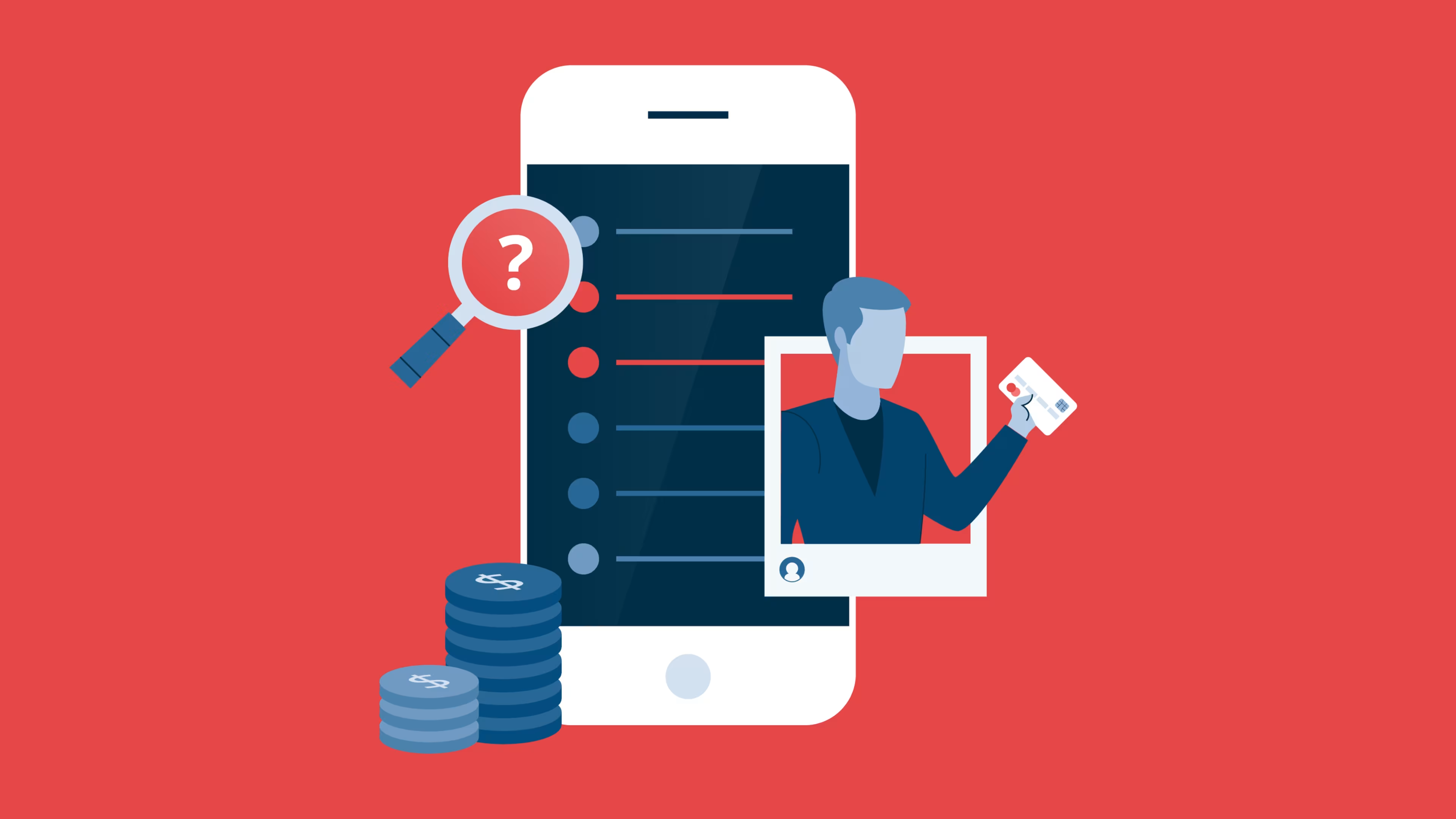19% of SMB managers say cash won’t become obsolete in the future—could they be wrong?
Leveraging digital payments used to be much more difficult for small and midsize businesses (SMBs). Unlike their larger competitors, they lacked the talent and technology required to fully support these systems. But the introduction of new real-time payment options like FedNow, alongside the growth of the digital economy during the pandemic, have slowly eroded these barriers.
Many companies are starting to reassess their reliance on physical currency for operations. Our Capterra survey finds that 81% of SMB managers think cash will become obsolete for business purposes within the next three to five years, and 90% expect that use of digital payments in their companies will increase in the future.*
If your business still primarily relies on cash or checks to carry out transactions or if it’s slow to adopt newer forms of payment technology, it stands to lose out if you don’t adjust your payment processes for the times ahead.
/ Key findings
30% of SMB managers say their businesses are cashless, and 81% feel that within the next three to five years, cash will become obsolete for business purposes.
90% expect that use of digital payments in their companies will increase in the future, with credit or debit cards, mobile payments, and mobile wallets being payment solutions companies leverage the most.
42% say that their overall customer experience has improved as a result of using digital payments; other benefits identified include increased revenue and operational efficiency.
95% say that they encounter challenges when using digital payments, the leading of which are security concerns, high-transaction fees, and technical issues.
59% say that, in light of the announcement of FedNow, they’re very likely to switch from other providers to the government’s real-time payments (RTP) network.
What are digital payments?
Digital payments refers to making transactions online or using technology, without the use of physical cash or checks. Examples of these payment types include credit or debit cards, wire transfers, and cryptocurrency. A little less than half of SMBs managers share that operations have become more efficient because they use digital payments, and a similar number say that these payment types have helped them save time when handling transactions.
SMB managers also say that facilitating digital payments in their business allows them to offer more payment options to a broader range of consumers. Not only do 42% of respondents share that harnessing digital payments has improved the overall customer experience they provide, 35% relay that revenue has increased as a result.
Cashless business models are on the rise but for many companies, this shift is unwise
The idea of a cashless economy feels like it could be more and more of a reality with each coming year. A growing number of consumers across the U.S. are relying less and less on cash each year, and 41% say that none of their purchases in a typical week use cash.[1]
Out of the SMB managers we surveyed, 30% report that their company is currently cashless, and a little less than half say they plan to become cashless within the next one to three years. On average, digital transactions made up 64% of SMBs’ sales in the last financial year. While this is a significant portion of their revenue, cash on average is still contributing to a notable chunk of many businesses' profits, indicating that shifting to a cashless business model could drastically impact their bottom line.
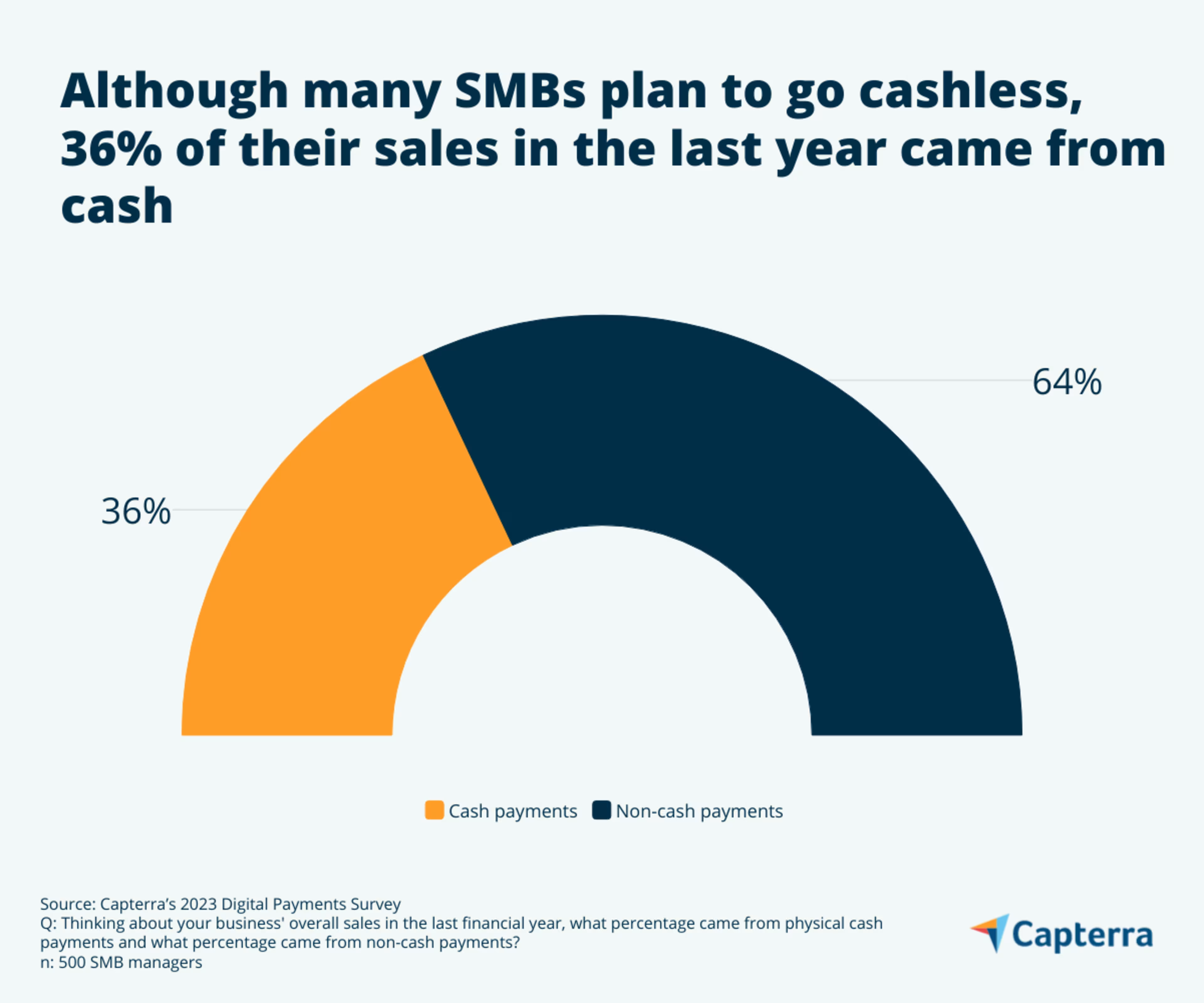
While 81% of respondents feel that cash will become obsolete for business purposes in the next three to five years, this doesn’t mean organizations should neglect using cash altogether. Across the U.S., many cities have banned or plan to crack down on cash-free businesses, citing that they exclude low-income consumers and others who are underbanked or slow to adopt digital payment methods.[2]
/ Our recommendation
While digital payments are clearly on the rise, cash is unlikely to go anywhere soon. Carefully consider the impact going cashless could have on your profits, operations, and on your consumers. Don’t forget that paying in cash can be advantageous. Your business can sidestep transaction fees and avoid accumulating credit card debt, and some vendors even offer discounts to companies that deal in cash.
Digital payments are not only the future, they're more secure for most transactions
Overall, 90% of SMB managers expect that their company's use of digital payments will increase in the future. The majority of respondents say that they prefer to use or accept credit or debit cards. Further, 76% of SMB managers say their companies use mobile payments supported by digital payment platforms, such as Zelle, and 72% say their companies leverage mobile wallets—like Apple Pay—to facilitate transactions.
Mobile payments and wallets in particular have become popular with consumers due to the convenience and ease of use they provide, as transactions can be made remotely and securely using just a smartphone. The use of these payments spiked during the pandemic as customers preferred to use contactless methods for purchases. Younger generations continue to drive the growth of this trend, enticed by rewards and loyalty programs these solutions offer. Buy now, pay later, which 45% of businesses offer and accept, is another increasingly attractive option for consumers.
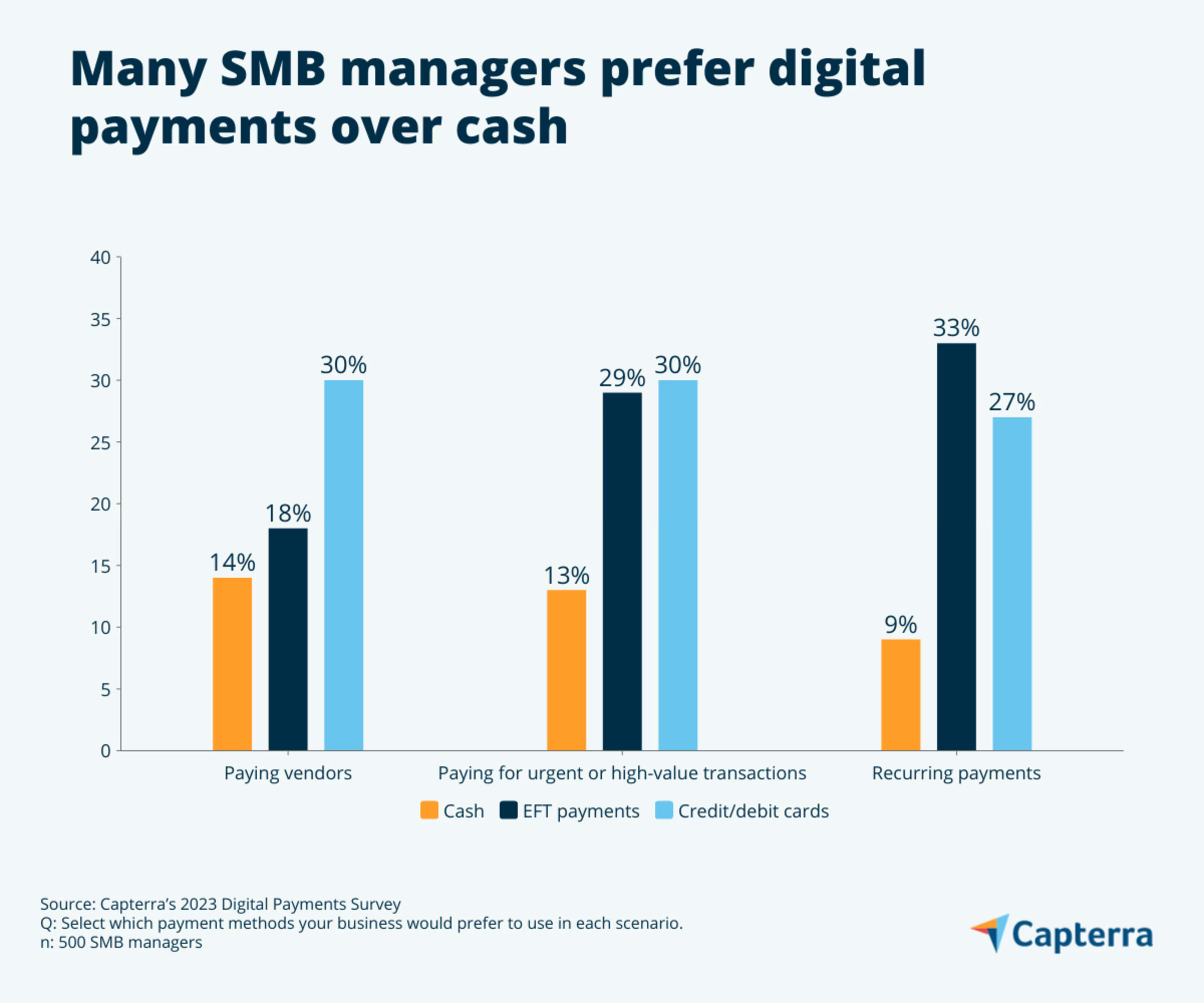
For many B2B (business to business) scenarios, however, these relatively newer forms of digital payments see less use. For example, only 7% of SMB managers report that their companies prefer to use mobile payments to pay vendors, compared to 30% who say that their companies default to credit cards or debit cards.
Close to a third of SMB managers share that their businesses use credit or debit cards or EFT payments—which include automated clearing house (ACH) or wire transfers—to finance urgent or high-value transactions. However, EFT payments are favored when it comes to handling payroll, taxes, or other recurring payments.
/ Our recommendation
Compared to using cash or checks, digital payments offer businesses a more convenient and secure way to handle both B2C and B2B transactions. Not only are digital payments less susceptible to fraud, they make it easier for businesses, both in volume and sum, to facilitate payments on a larger scale. Additionally, the digital footprint left behind in virtual transactions can help organizations streamline cash flow and financial record-keeping. Be wary, however, of accepting certain digital payments like cryptocurrency, which is extremely vulnerable to fraud, not insured, and currently subject to crackdowns by U.S. regulators.[3]
Fraud and high transaction fees tarnish the benefits of digital payments
Despite the many benefits they bring businesses, digital payments aren’t infallible—95% of respondents who use these payment types report running into obstacles, which include everything from technical issues to hurdles associated with accepting more esoteric payments like cryptocurrency.
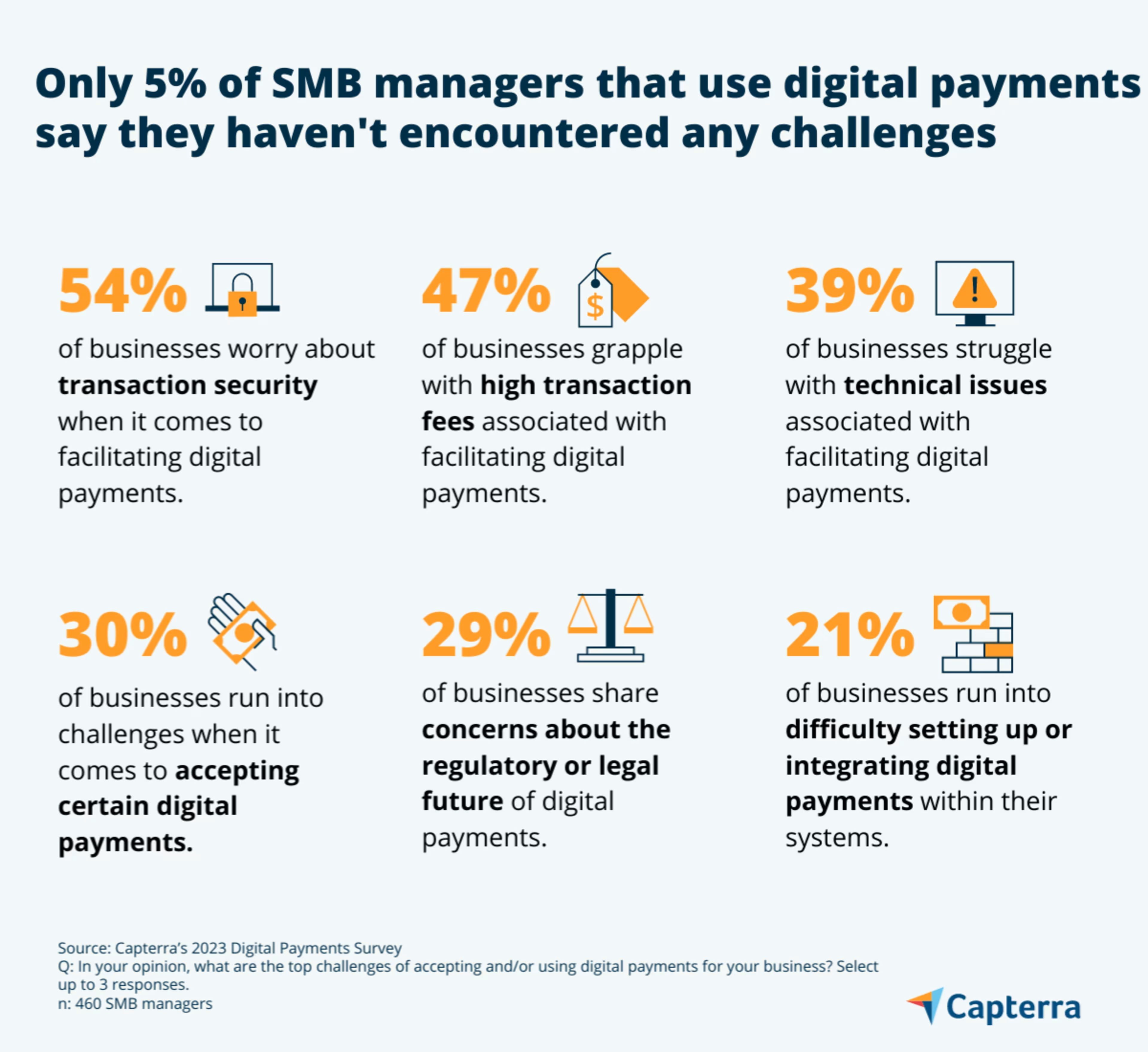
A chief concern among more than half of SMBs managers is the fact that, while digital payments are more secure than cash or checks, they’re not immune to fraud. There are more built-in security safeguards for digital payments than cash or checks, but the virtual ecosystem still poses danger for SMBs.
Digital payments involve multiple parties and payment types that are all interconnected via various networks and platforms. Cybersecurity safeguards aren’t uniform across these banks, payment processors, and merchants, which gives hackers numerous angles to exploit the weakest link in these systems. This can result in data breaches, account takeovers, or other security risks.
Almost half of SMB managers say they struggle when it comes to using digital payments because of high transaction fees—costs that, like security, are influenced by who companies choose to partner with.
On average, respondents say that these fees cost them between $5,000 to less than $10,000 each month. Surprisingly, 22% of SMB managers say that, when it comes to deciding to work with a bank or a third-party provider, their company has no preference.
A majority of respondents prefer to work with a bank to process and support digital payments, with a little less than a quarter favoring third-party providers. Choosing the right provider ultimately depends on a business’ unique requirements and priorities, but there are advantages and disadvantages for both options:
Banks tend to provide more secure services and are especially useful for businesses that frequently make international sales or pull in a high volume of transactions. The trade-off is higher costs and more complex solutions that are harder to set up.
Third-party providers are generally less secure and offer limited financial service assistance beyond payment processing, but they’re more cost-effective for businesses and easier to set up and integrate.
/ Our recommendation
Your business needs to have strong cybersecurity safeguards; it's also critical that you partner with a payment provider that prioritizes the same. And no matter which provider you choose to work with, proactively finding ways to reduce transaction fees is a must. Unwieldy fees can impact cash flow, bump up operating costs, and eat into profit margins, so companies that use digital payments should routinely look for ways to minimize these costs. Prioritize the most cost-effective digital payment offerings for both you and your consumers, and make sure to regularly review and negotiate your payment terms.
FedNow makes real-time payments accessible for SMBs
The infrastructure that enables electronic transactions to take place is known as banking rails, which encompass a wide range of systems and networks that include the ACH, payment processors, and more. These rails allow consumers and businesses alike to move money, make payments, and manage their assets.
One of the latest developments within this ecosystem is real-time payments (RTPs). Currently, 58% of SMB managers say their companies use RTPs and 34% plan to harness this technology in the future.
RTP networks set themselves apart from other banking rails due to the fact that payments facilitated via these systems are initiated and settled almost instantaneously. Payments can be sent at any time and on any day. Unlike traditional banking rails like the ACH, transactions aren’t sent in batched delays. Rather, RTP systems process and finalize transactions as they come in. Another key distinction is that RTP transactions can only be initiated by the sender and not requested by the recipient or a third party.
Almost half of respondents report that being able to access funds immediately is a major benefit of RTPs. Close to a third of SMB managers also share that they’re motivated to use these systems because they lower transaction costs and make conducting these processes much more convenient.
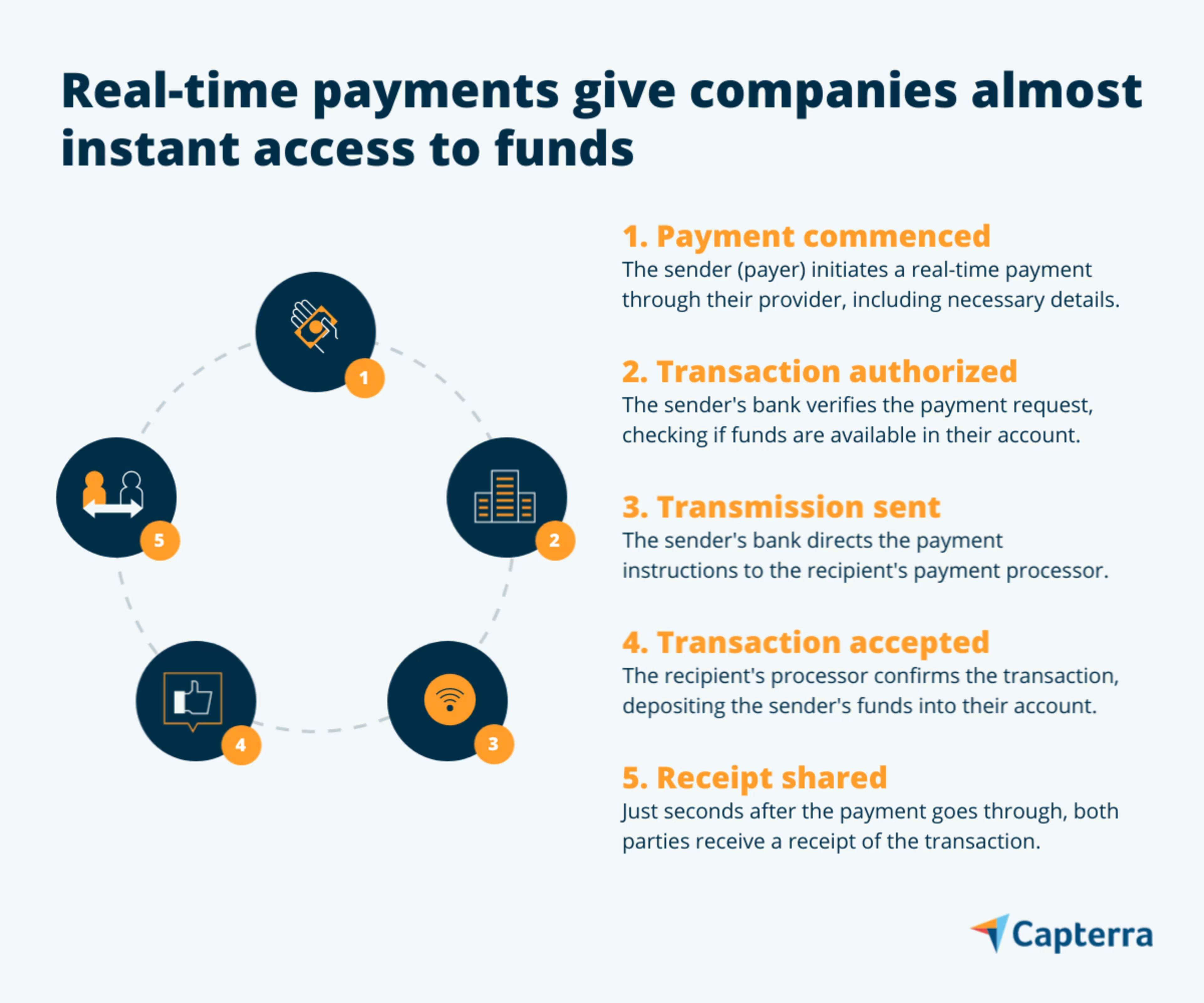
More than half of SMB managers say they prefer working with a third-party provider like Zelle to facilitate RTPs, though a large portion lean toward working with The Clearing House’s RTP Network. Last July, however, the Federal Reserve launched its own RTP system—FedNow—and 59% of SMB managers that use or plan to use RTPs through other providers say that they’re very likely to switch to the government’s new system.
Though some businesses say they’re likely to switch to FedNow because it can potentially lower transaction costs, a majority are drawn to this new system because it will open up RTPs to a wider pool of banks and financial institutions. Another attractive aspect of FedNow for 36% of SMB managers is the added security and governmental oversight a federal network stands to provide.
/ Our recommendation
You should examine your current payment systems and processes to see if adopting RTPs or switching to FedNow is right for your business. Connect with your financial institution to determine if they offer RTPs or plan to integrate FedNow’s services into their system and ask about any steps your business should take to prepare. This could mean you might need to update your accounting systems and software so that they work with a RTP network. In light of any needed changes, don’t forget to alert your team and provide training accordingly.
Digital payments will grow and change—so should your payment processes
Managing payment systems effectively is crucial for your business. Digital payments are becoming a bigger part of the picture, but taking advantage of these offerings while minimizing the risks they carry is easier said than done. Thankfully a variety of software tools exist to help streamline this undertaking.
Here are a few solutions you can explore to see if they’re a right fit for your business:
Accounts payable/receivable software: Managing the money you owe to organizations and what clients and vendors owe to you can get tricky fast. These solutions automate recording payments that flow in and out of your business, and among other benefits, can help lower transaction costs.
Billing and invoicing software: Simpler forms of these solutions can help your business automate payment invoicing, receiving, and processing. More complex software can even track time and expenses or let you design custom, branded invoices.
Financial management software: To aid in long-term financial planning and forecasting, your business can use these solutions to analyze the data gleaned from transactions to help choose the most cost-effective payment methods and platforms.
Transforming your payment systems won’t happen overnight and should be part of a broader financial plan for your business. Checking out the top trends that will define the field of finance in the coming year will help your business prepare for whatever the future of digital payments has in store.

